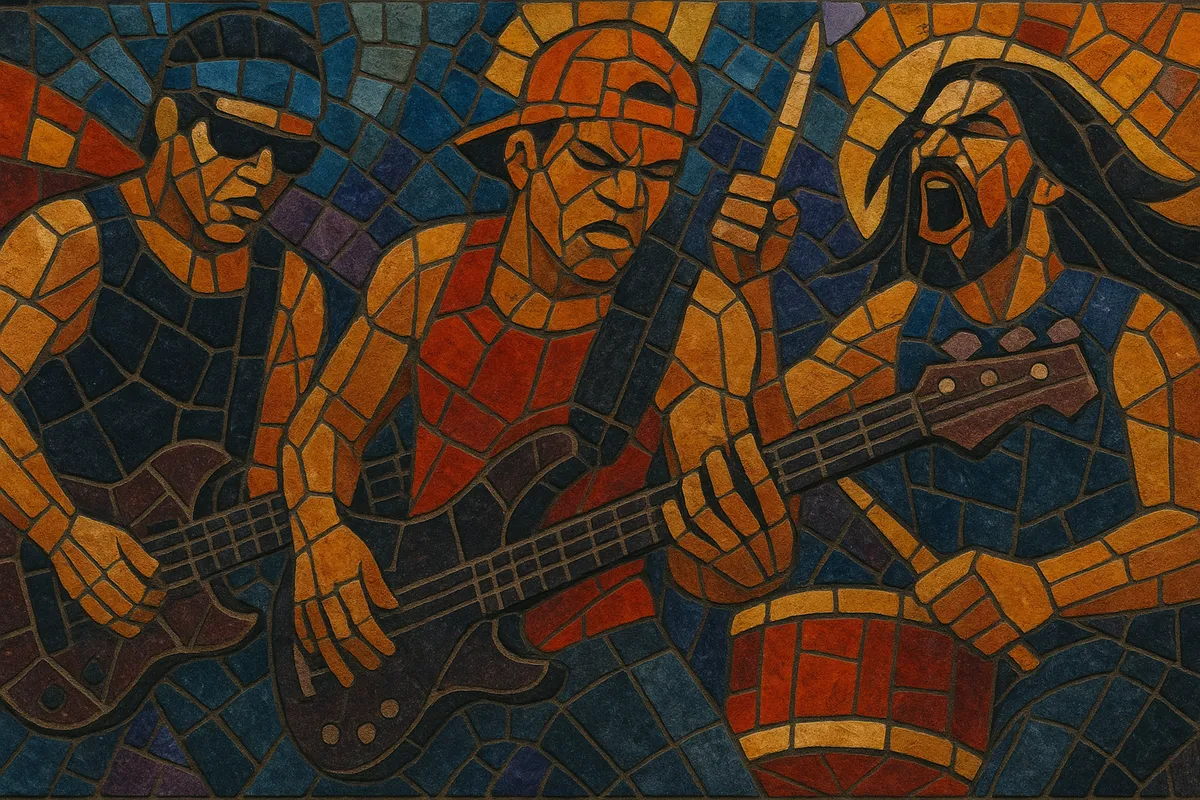Funk metal is a high-energy fusion that marries the syncopated grooves and slap-driven bass of funk with the distorted riffs, power, and aggression of heavy metal and hard rock.
Characterized by percussive guitar work (often using wah/envelope filtering and muted strums), tight, syncopated drum patterns, and virtuosic, popping/slapping electric bass, the style favors rhythmic interplay and punchy dynamics over dense harmonic movement. Vocals range from soulful singing to shouted chants or half-rapped cadences, with lyrics that can be humorous, satirical, or socially observant.
The result is music that is both danceable and heavy, inviting mosh-pit intensity while retaining the elastic, body-moving feel of funk.
Funk metal coalesced in the United States as musicians steeped in funk and punk sought the weight and spectacle of metal. Proto-examples include hard-funk outfits like Mother's Finest and the punk–funk experiments around the U.S. underground, but the style clarified when bands began pairing slap-bass grooves with hard rock/metal guitar tones and stage energy.
The late 1980s brought mainstream visibility: Living Colour’s Vivid (1988) placed intricate, groove-forward riffing and social commentary on MTV; Faith No More’s The Real Thing (1989) mixed funk-inflected rhythm sections with metal guitars and genre-fluid vocals; and Red Hot Chili Peppers’ Mother’s Milk (1989) and subsequent work pulled their previously funk-rock sound into heavier territory. Primus (Frizzle Fry, 1990) pushed the bass-first, oddball aesthetic; Fishbone, 24-7 Spyz, Infectious Grooves, and Mordred expanded the palette, incorporating thrash bite, ska, and playful humor. Lollapalooza-era touring and video rotation popularized the sound.
As alternative metal and rap-metal rose, funk metal’s DNA spread outward. Bands applied funk’s syncopation to metal riffing (helping lay foundations for rap rock/rap metal) and emphasized groove in heavier contexts (presaging aspects of nu metal). While the pure label "funk metal" became less common, its techniques—slap bass in heavy music, percussive guitar chanks, and danceable, syncopated drumming—remained influential.
Today, funk metal is both a distinct catalog of classic bands and a set of techniques absorbed by alternative metal, rap metal, and nu metal. Its enduring contributions are rhythmic: a focus on groove, space, and bass-forward arrangements inside heavy music.
Start with a syncopated, danceable foundation at medium to brisk tempos (90–140 BPM). Use backbeat accents on 2 and 4, ghost notes on snare, and linear kick–snare patterns that interlock with the bass. Prioritize tightness and space so each hit feels purposeful.
Make the electric bass the driver of the song. Write riffs using slap and pop (thumb and index/middle), hammer-ons, pull-offs, and left-hand muting. Favor pentatonic, Dorian, and Mixolydian flavors with chromatic approach tones. Consider 5-string or detuned setups to balance sub weight with percussive attack.
Blend heavy, palm-muted riffs with percussive "chank" upstrokes and muted strums. Use wah, envelope filter, light chorus, and occasional octave pedals. Riffs should complement the bass’s syncopation: leave rests, answer phrases, and punctuate with stabs rather than constant wall-of-sound chugging. Drop-D or standard tuning both work; keep chords tight (power chords, dyads) and add rhythmic dead notes for funk feel.
Combine funk vocabulary (ghost notes, linear phrasing, hi-hat openings, syncopated kicks) with rock/metal power (crisp snare crack, punchy kick). Ghosted 16ths on snare and offbeat hat openings help the groove breathe. Use occasional tom-led fills to accent transitions without overcrowding the pocket.
Vocals can switch between melodic hooks, shouted lines, and rhythmic, near-rap cadences. Lyrics often balance humor and social commentary; keep phrasing rhythmically aligned with the groove so vocals feel like another percussion instrument.
Keep harmony simple and riff-centric (one–three tonal centers per song). Use Dorian and minor pentatonic for gritty, funky color. Structure with clear hooks: intro riff, verse groove, pre-chorus lift, big chorus, and a breakdown/bridge that spotlights bass–drum interplay.
Aim for a dry, punchy mix. Give bass ample headroom and definition (parallel compression, slight midrange boost around 700–1.2 kHz for articulation). Keep guitars tight and not overly layered; let transients through. Emphasize the drum pocket (fast attack, medium release compression on kick/snare) and leave space in the low-mids to avoid mud.


